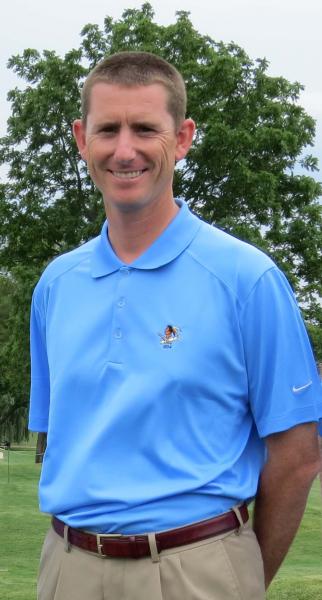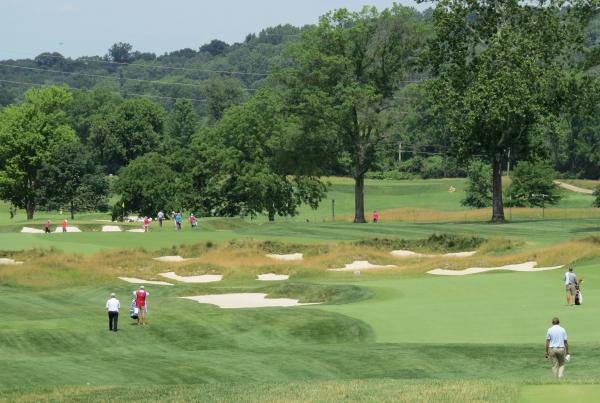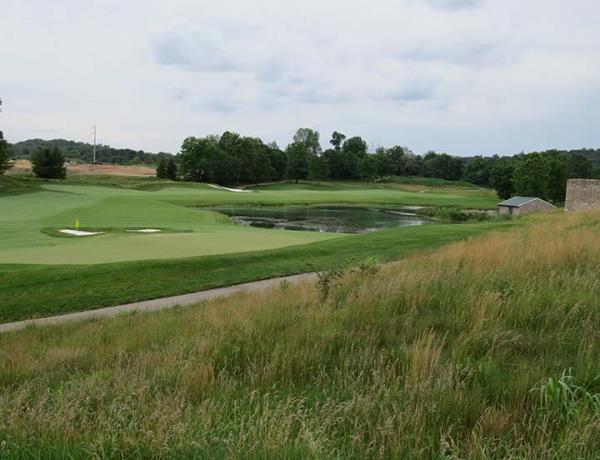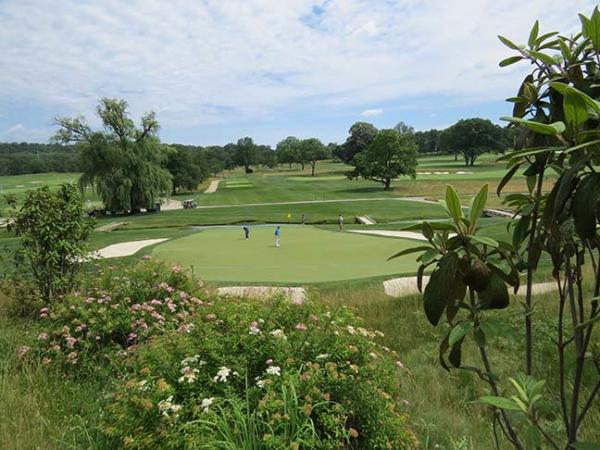
When a golf course architect's dying wish is to have his ashes scattered in the stream that runs past his home course, it's safe to conclude he was a fan of his own handiwork.
Much of the bite A.W. Tillinghast put into his 1922 design at the Philadelphia Cricket Club had been lost in the decades since 1942 when his ashes were sprinkled into nearby Wissahickon Creek. Once Tilly's pride and joy, the course garnered nary a sniff from the game's biggest bodies as they sought tournament sites in the Philadelphia area. After a 2013 restoration by architect Keith Foster that was designed to recapture some of Tilly's magic, the Cricket's Wissahickon Course has teeth again with features such as "The Great Hazard," and the 1922 Tillinghast classic is on the tournament radar with three events in six years.
This year, the PGA Professional National Championship - the biggest event of the year for PGA professionals, the top 20 of whom qualify for this year's PGA Championship - was held at the Cricket. Next year, the Constellation Senior Players Championship will be held on the Wissahickon Course as will the USGA's U.S. Amateur Four-Ball Championship in 2020.
"We haven't had tournament golf here for 100 years," said Dan Meersman, the club's director of grounds since 2009. "Now, we're going to make up for it in six years."
Managing turf, and just about everything else at a place as large as the Cricket is no small task for the 37-year-old Meersman, winner of the 2012 TurfNet Superintendent of the Year Award, presented by Syngenta. And make no mistake about it, there is no moss growing under his feet. Meersman is a man constantly on the move. He has to be because he has a lot of ground to cover across two campuses.
Known as the nation's oldest country club - it was founded in 1854 - the Cricket is located in multiple cities and towns, including the Chestnut Hill section of northwestern Philadelphia and the Flourtown section of Springfield Township. The property also borders a state park. Aside from 45 holes of golf, Meersman also oversees squash and lawn tennis facilities, clay tennis courts, a paddle tennis complex, pool area and all the common grounds throughout both campuses. Getting things done requires not only consensus from the club's many constituencies, but can often include getting an OK from decision-makers from the township and the city as well.
"There are so many moving parts here with members, departments and staff," Meersman said.
"And working with different municipalities, you have to develop relationships quickly. You also have to know who the township engineer is. You have to know the police chief, you have to know the fire chief. Then you go to the City of Philadelphia, and it's a different set of people. Once you know everyone, it streamlines everything you are doing, but you do have to spend time getting folks on board early."
He walks at a brisk pace while making his rounds, greeting everyone he encounters between Points A and B (as well as C, D, E, F and G) with a smile and a courteous salutation. Most members he comes across recognize him, and all other club employees know who he is.
Players during the PGA Professional National Championship go out of their way to thank him for producing a course that is a tough, but fair test of golf, not to mention in immaculate condition. Members in one of the many buildings on the property or serving as tournament officials line up to compliment him on his work. Fellow employees tell him the same, or stop him to say "so-and-so, told me to tell you the course looks great."
Even Ben Kimball of the USGA's competitions committee, upon seeing the Wissahickon Course immediately after the restoration in 2013, told Meersman "(the USGA) could host something here right now."

"When you inherit a golf course, you are inheriting the Titanic, not a speedboat that you can turn around quickly. It takes time," Meersman said.
"In the restoration, we used a lot of sod, so we went from dirt to ?oh my' in two days.
Based on the accolades, praise and thanks others heap on Meersman, it would be understandable if he were to become comfortable or complacent. A third-generation superintendent, Meersman is the exact opposite of complacent. He learned the ways of a business early, when as a boy he and brother Jason - also is a superintendent - visited their father Mike's maintenance shop in the mornings before heading off to school. Today, his attention to detail is evident when he stops each time he sees something as small as a candy wrapper, picks it up and throws it away. If there isn't a garbage can nearby, the trash is filed temporarily in his pants pocket until something more appropriate is located.
Improvement projects at the Cricket often can come in bunches, and for good reason.
"We have to elevate each campus simultaneously for things to pass," Meersman said. "When they passed the Wissahickon restoration, they also passes a squash court expansion, the paddle tennis hut and some redesign of the pool pavilion. Then when all that passed, I proposed restoring the St. Martins Course before the Wissahickon restoration.
"It's important to get out with different people. There are many different member groups, and you really don't want to get pegged as favoring one over another."
Members here expect a lot, and Meersman delivers. Golfer expectations at a place like the Cricket Club are always at an elevated level, but they are especially high here since the Wissahickon restoration. A membership drive in advance of the restoration yielded an influx of young, skilled players.
The level of everyday play here has helped ease selling parts of the restoration, namely the addition of some hazard features, including The Great Hazard, that were in place when Tillinghast built the course, but were lost over time.
"We built the golf course to maintain at a high level," Meersman said.

The restoration served two goals: it stayed true to what Tillinghast put in the ground in 1922 while at the same time providing a fair test of golf for players of all skill levels. In the process, the Wissahickon's heralded restoration is a breath of fresh air to a facility that was the site of the U.S. Open in 1907 and 1910. Even then, the USGA's national championship was played on the St. Martins Course, and 1895 design that opened as a nine-hole layout and was expanded to 18 holes two years later. As evidence of the changes that have occurred through the decades at the Cricket Club, the St. Martins Course is again a nine-holer complete with its original square putting surfaces.
A quote by Tillinghast cited in a video to commemorate the restoration attempts to connect golf course architects to those who play on their creations: "This attention of the golfers at-large to details of course planning and construction must be welcome indeed to be leaders of their craft, the architects whose greatest reward is the approval of those whom they seek to please."
A complex of 13 bunkers in a waste area in the middle of the No. 7 fairway known as The Great Hazard, a raised green protected by bunkers on No. 14 and a fescue-covered hillside on No. 15 are designed to penalize golfers for errant shots, not swallow golf balls.
"It's a Tilly golf course, and it was intended to honor Tilly and to reintroduce all of these great Tilly features that at one time had been kind of watered down," Foster said in the Cricket Club video. "A.W. Tillinghast was a member at this course. This was his home course. He's from Philly, which is really quite important, and to now have the opportunity to reintroduce the world to what Tilly did here at his home golf course is really, really special."
It wasn't enough to get such features included into the restoration blueprints, Meersman and Foster also worked to get them into a published set of standards that was voted upon by members.
There is a sinister side to Meersman, who chuckles almost on queue each time he discusses the difficulty built into the course. Talking about these new native features and the process of getting the club to approve how they are to be maintained is no different.
"(The Great Hazard) is a native feature in the direct line of play that is 50 yards wide. Sooner or later, this is going to become a topic for discussion," Meersman said with a laugh. "We got together with the architect and the committee because this is going to be a tough feature for some.
"When the restoration is done, Keith is gone. I knew I'd have to do something. I checked the (standards) with Keith, and he was OK with them, so we took them to the club. Once we put those in, the biggest fear for the club was that they had worked five years getting this restoration teed up for a vote. They'd walked through the mud with Keith. The last thing we wanted was someone coming in and telling you to change things and filling in bunkers.
"I now have something I can defend."

Those standards allow Meersman to maintain these areas as hazards as long as they don't get overgrown to the point where lost balls become a recurrent problem.
"The members here have so much pride in this place, and now they have a key feature that is different," Meersman said. "To be a feature, it has to be something that is not normal, otherwise it would look like bunkers you can see anywhere and no one will remember or have a reason to celebrate.
"If you can't find your ball and the hazard is in play, then I think that is a legitimate argument. If you lose your ball in the direct line of play, you should be able to find it.
"The standards also build in a level of staff accountability. We have high standards, and our guys know how to hit them."
Once covered by trees, the fescue hillside is another matter. Buttressed with railroad ties, the feature adds aesthetic appeal and helps to naturally control weed pressure.
"The more you're in there thinning it, the more weed pressure you're going to have. The more weed pressure you have, the more you going to be in there pulling those too," Meersman said.
"These features are far from natural. It's a gorgeous fescue and everything is wonderful about it, but to pull that off takes a lot of work. In this case, the railroad trestles and visual aesthetics of the feature trumps your playability. That's the way the architect designed it, and that's what we all agreed to."

